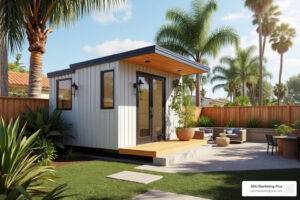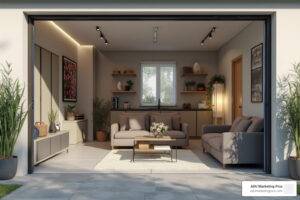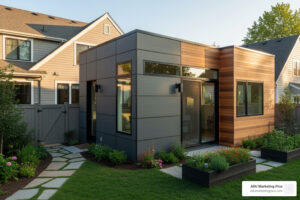Why Prefab ADUs Are Changing Southern California Backyards
In the dense, high-demand housing market of Southern California, the dream of expanding a home often clashes with the reality of limited space, soaring construction costs, and lengthy project timelines. Enter the solution that is revolutionizing backyards from San Diego to Santa Barbara: prefab adu southern california options. These factory-built accessory dwelling units (ADUs) are not just a trend; they represent a fundamental shift in residential construction, offering a faster, more affordable, and significantly less disruptive alternative to traditional building methods.
For decades, the region has grappled with a housing shortage, pushing property values to astronomical heights and making conventional additions or new builds financially prohibitive for many. Prefab ADUs directly address this challenge. By streamlining construction within a controlled factory environment, builders can deliver high-quality, energy-efficient homes in a fraction of the time—often 6-12 months from start to finish. This efficiency translates into predictable costs and minimal disturbance to your daily life, with the main structure often installed in a single day.
Recent updates to California law have poured fuel on this fire, creating an unprecedented opportunity for homeowners. The state’s commitment to increasing housing density has led to regulations that allow for larger ADUs, reduced property line setbacks, and waived parking requirements in many areas. This favorable regulatory climate, combined with the inherent advantages of prefabrication, makes adding a second unit more feasible than ever.
As one satisfied homeowner noted, “It’s a great look. In 10 years, it’ll still look good. And in 20 years, it’ll still look good. It’s pretty classic.” This sentiment captures the essence of the modern prefab ADU: a durable, stylish, and intelligent investment. Whether you’re aiming to generate rental income, provide a private home for family members, or create the ultimate home office, prefab ADUs deliver quality, speed, and style to meet the unique demands of Southern California living.
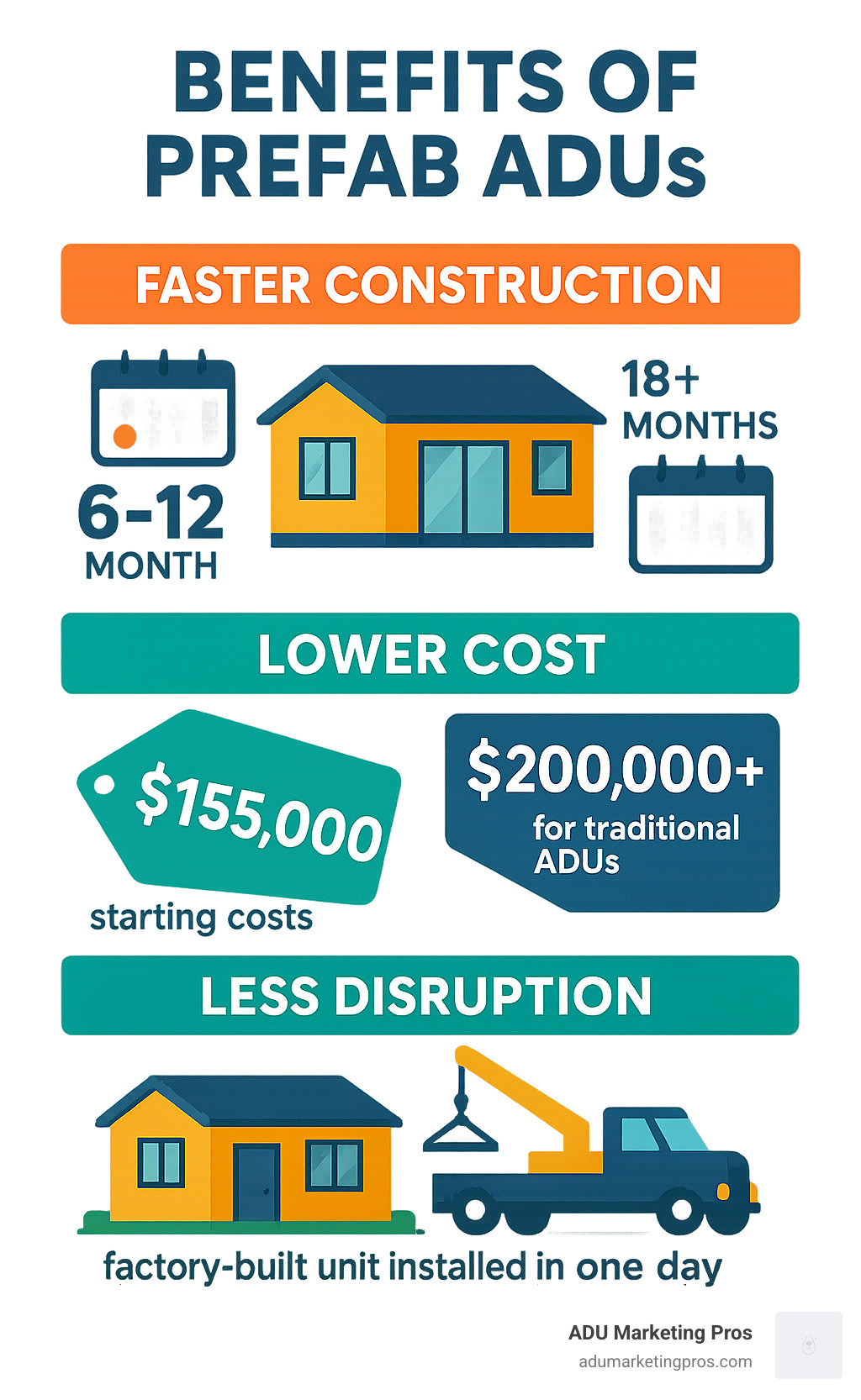
Prefab adu southern california word guide:
Why Prefab ADUs are Booming in Southern California
The explosive growth in demand for prefab ADU Southern California solutions is a direct and intelligent response to the well-known headaches of traditional, on-site construction. For homeowners weighing their options, a direct comparison between prefab and site-built methods reveals clear and compelling advantages in cost, speed, quality, and overall convenience.
-
Predictable Costs and Significant Savings: Traditional construction is notorious for budget overruns due to unforeseen issues, weather delays, and fluctuating material costs. Prefabrication mitigates these risks. Builders purchase materials in bulk, reducing costs, and the streamlined factory process minimizes waste. Labor is used with maximum efficiency, leading to more predictable, fixed pricing. While every project has site-specific variables, the core cost of the structure is locked in, often resulting in substantial savings over a comparable site-built project.
-
Best Speed of Construction: A conventional ADU build can easily stretch to 18 months or more, with your backyard resembling a construction zone for the duration. A prefab ADU can be designed, built, and move-in ready in as little as 6 to 12 months. This remarkable speed is achieved through parallel progress: while your property is being prepared with foundation and utility work, your home is simultaneously being constructed in a factory. The final installation of the finished modules can take as little as a single day, dramatically compressing the on-site timeline.
-
Minimal On-Site Disruption: With up to 90% of the construction happening off-site, the impact on your daily life is drastically reduced. Instead of months of relentless noise, dust, and a parade of contractors, the on-site phase is condensed and efficient. This is a game-changer for families with children, pets, or those who work from home, preserving peace and privacy throughout the majority of the project.
-
Superior, Factory-Controlled Quality: Building a home in a climate-controlled factory eliminates exposure to the elements, preventing issues like warped lumber or weather-damaged materials. Factory settings allow for a level of precision and consistency that is difficult to replicate in the field. Each unit is subject to rigorous, multi-stage quality control inspections, ensuring that every detail, from framing to finishes, meets exacting standards. This results in a more durable, airtight, and resilient structure.
-
Design Certainty and Versatility: Prefab ADUs remove the guesswork. You can often tour a model home or view detailed 3D renderings, so what you see is precisely what you get. This eliminates the risk of on-site misinterpretations of blueprints. Beyond this certainty, the versatility is immense. Homeowners use these units to generate passive ADU Rental Income, provide a safe and independent space for an ADU for Aging Parents, or create a quiet, productive ADU Home Office. Many builders are also leaders in Sustainable ADU Designs, integrating eco-friendly materials and high-efficiency systems that benefit both the planet and your utility bills. This powerful combination of practicality, quality, and flexibility is why prefab ADUs are reshaping backyards across the region.
Navigating the Rules: ADU Laws in Southern California
Starting on a prefab adu southern california project requires understanding the local and state regulations, a landscape that can seem complex. Fortunately, a series of landmark state laws, enacted to combat California’s housing crisis, have dramatically simplified and streamlined the approval process for homeowners. Key legislation passed in 2020 and updated since has created a more predictable and favorable environment for ADU construction.
One of the most significant changes is the mandate that local agencies must approve or deny a completed ADU permit application within a 60-day review period. This crucial rule prevents the indefinite delays that once plagued projects, providing homeowners with a clear and reliable timeline. While a comprehensive understanding of all ADU Regulations California is beneficial, these statewide standards have paved a much smoother path forward.
Key State-Level Regulations
These statewide rules form the foundation for all ADU projects in Southern California:
- Size and Height Limits: You can generally build a detached ADU up to 1,200 square feet. State law also allows for an ADU of at least 800 square feet and 16 feet in height, regardless of other local development standards like lot coverage or floor area ratio. To learn more, see How Big Can an ADU Be in California?.
- Reduced Setbacks: A setback is the required distance between your structure and the property line. State law has reduced this to just 4 feet for side and rear yards, a major benefit for maximizing space on smaller urban and suburban lots.
- Parking Waivers: ADU Parking Requirements are waived in many common scenarios. For example, no additional parking is needed if your property is within a half-mile of public transit, in a historic district, or if the ADU is part of an existing structure.
- Multiple Units Allowed: On a single-family lot, state law permits one detached ADU and one Junior ADU (JADU), which is a unit created within the walls of the primary home. For multi-family properties, property owners can often build up to two detached ADUs.
- No Owner-Occupancy Requirement: A statewide mandate requiring the property owner to live in either the main house or the ADU has been suspended through 2025 and may be extended, offering greater flexibility for rental property investors.
- Impact Fee Reductions: For ADUs under 750 square feet, local agencies cannot charge impact fees, which are fees for the new unit’s impact on public services and infrastructure. For larger ADUs, these fees must be proportional to the size of the ADU relative to the main house.
Local City Ordinances and HOAs
While state law sets the minimum standards, it’s crucial to remember that local city ordinances still play a significant role. Cities across Southern California have their own specific requirements for utility connections, design guidelines, and fee structures. For example, the city of Los Angeles offers a program of Pre-Approved ADU Plans Los Angeles to expedite permitting, while San Diego may have different rules regarding coastal zones. An experienced local builder will be an expert in navigating the nuances of your specific city’s planning department and its definition of things like Floor Area Ratio (FAR).
Furthermore, if your home is part of a Homeowners Association (HOA), they cannot outright prohibit the construction of an ADU. However, they can enforce reasonable rules regarding design and aesthetics to ensure the new unit conforms to the community’s look and feel. This is another area where the expertise of a seasoned builder is invaluable, as they can manage the submission and approval process with both the city and your HOA on your behalf.
The Ultimate Guide to Prefab ADU Southern California Models
The modern world of prefab adu southern california is rich with diverse and sophisticated options, ranging from minimalist studios to expansive, family-friendly homes. Builders are constantly innovating with Modern ADU Floor Plans and high-end design packages, offering configurable layouts and designer-curated finishes to perfectly match your property and personal style.
Studio & One-Bedroom Units (Under 600 sq. ft.)
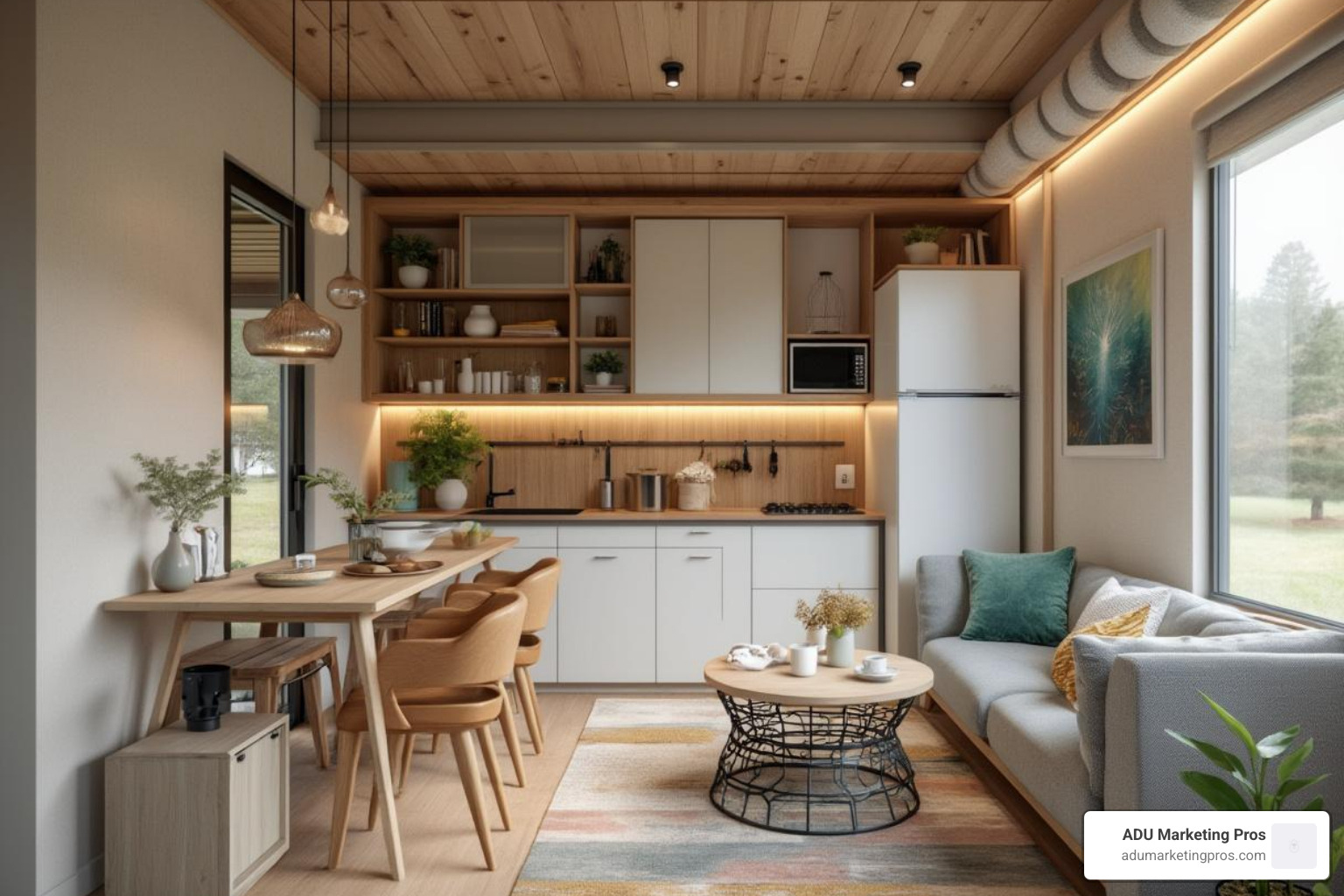
Compact units are the epitome of efficiency and affordability, making them a popular choice for a wide range of uses. They serve as ideal home offices, private guest suites, creative studios, or high-demand rental units for students and single professionals. Thoughtful Studio ADU Floor Plans masterfully use every square inch, often featuring open-concept layouts, high ceilings, and large windows to create a feeling of spaciousness. Designers incorporate clever, space-saving features like built-in storage solutions, pocket doors, and compact yet full-sized appliances. Even in a small footprint, you can find brilliant ADU Kitchen Ideas that deliver full functionality without sacrificing style. These smaller models represent the most accessible entry point into the ADU market.
Two-Bedroom & Family-Sized Units (600 – 1,200 sq. ft.)
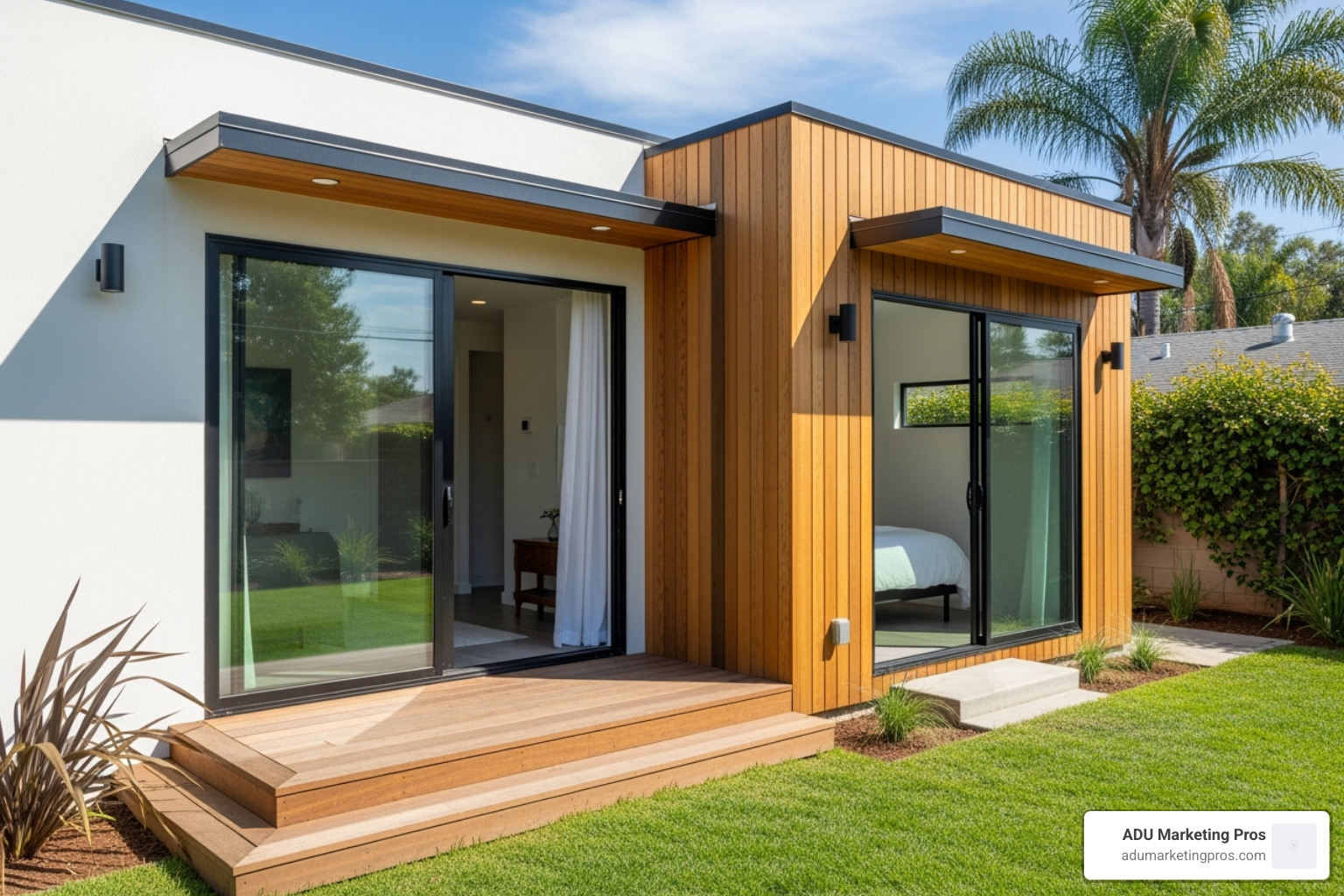
For those needing more space, larger prefab models provide a complete, comfortable living solution. These units are perfectly suited for multi-generational living, allowing aging parents to live close by while maintaining their independence, or for housing a small family. A well-designed 1200 Sq Ft ADU can feel as spacious and functional as a traditional single-family home, often featuring two or more bedrooms, multiple bathrooms, and full-sized laundry facilities. These models typically boast open-concept living and dining areas, gourmet kitchens, and seamless indoor-outdoor transitions with decks or patios. For the ADU Exterior Design, builders offer a wide palette of siding, roofing, and window options to either complement or stylishly contrast with your main house, ensuring perfect aesthetic integration.
Key Features to Look For
When comparing models, prioritize features that improve comfort, value, and long-term livability:
- Energy Efficiency: Seek out an Eco-Friendly ADU built to exceed California’s stringent energy codes. Standard features often include high-performance insulation, dual-pane windows, and efficient HVAC systems. Many units are also built with solar-ready roofs, allowing for an easy transition to renewable energy that can dramatically lower or even eliminate electricity bills.
- High-Quality, Resilient Materials: Durability is paramount, especially in California. Look for builders who use robust, low-maintenance materials. Some leading companies use cold-formed steel frames, which are non-combustible (a major advantage in wildfire zones), resistant to termites and mold, and engineered to withstand seismic activity.
- Healthy Living Environment: A quality builder will adhere strictly to the California Green Building Standards Code (CALGreen), which mandates the use of low-VOC (volatile organic compound) paints and materials. Some premium units go even further, offering advanced features like Energy Recovery Ventilators (ERVs) or hospital-grade air filtration systems for superior indoor air quality.
The Prefab ADU Journey: From Design to Move-In
The process of adding a prefab adu southern california to your property is a well-orchestrated journey, designed to be far simpler and more transparent than a traditional construction project. The best builders offer a comprehensive, turnkey process, acting as your single point of contact and managing every critical step. This streamlined approach, detailed in the typical ADU Building Process, expertly guides you from initial concept to the exciting move-in day.
-
Feasibility, Design, and Engineering: The journey begins not just with design, but with a crucial feasibility study. A professional assesses your property for factors like accessibility for a crane, topography, soil conditions, and the location of utility lines. Once feasibility is confirmed, you’ll collaborate with a design team to select a floor plan, customize your layout, and choose from a catalog of interior and exterior finishes. The builder then produces the full set of architectural and engineering documents required for permitting.
-
Permitting and Approvals: This is often the most daunting phase for homeowners, but a turnkey builder handles it all. They manage the complex ADU Permit Process by preparing and submitting all necessary paperwork—including site plans, floor plans, structural calculations, and Title 24 energy reports—to your local city or county planning department. They act as the liaison, responding to any questions from plan checkers to ensure full compliance and secure your building permit.
-
Off-Site Fabrication & On-Site Preparation: This is where the magic of prefab happens. While your permit application is being reviewed, your ADU is already being built in the controlled environment of a factory. This parallel workflow is the key to the compressed timeline. Simultaneously, a crew begins work at your property. This site prep phase includes any necessary demolition, grading the land, trenching for utility lines (water, sewer, electrical), and pouring the concrete foundation.
-
Delivery and Installation: Once the factory build is complete and your foundation is cured, it’s time for delivery day. The ADU modules are transported to your property by truck and then expertly lifted by a crane, often over your main house, and precisely set onto the foundation. This dramatic and efficient installation process is typically completed in just a single day, changing your empty backyard into a nearly-finished home in a matter of hours.
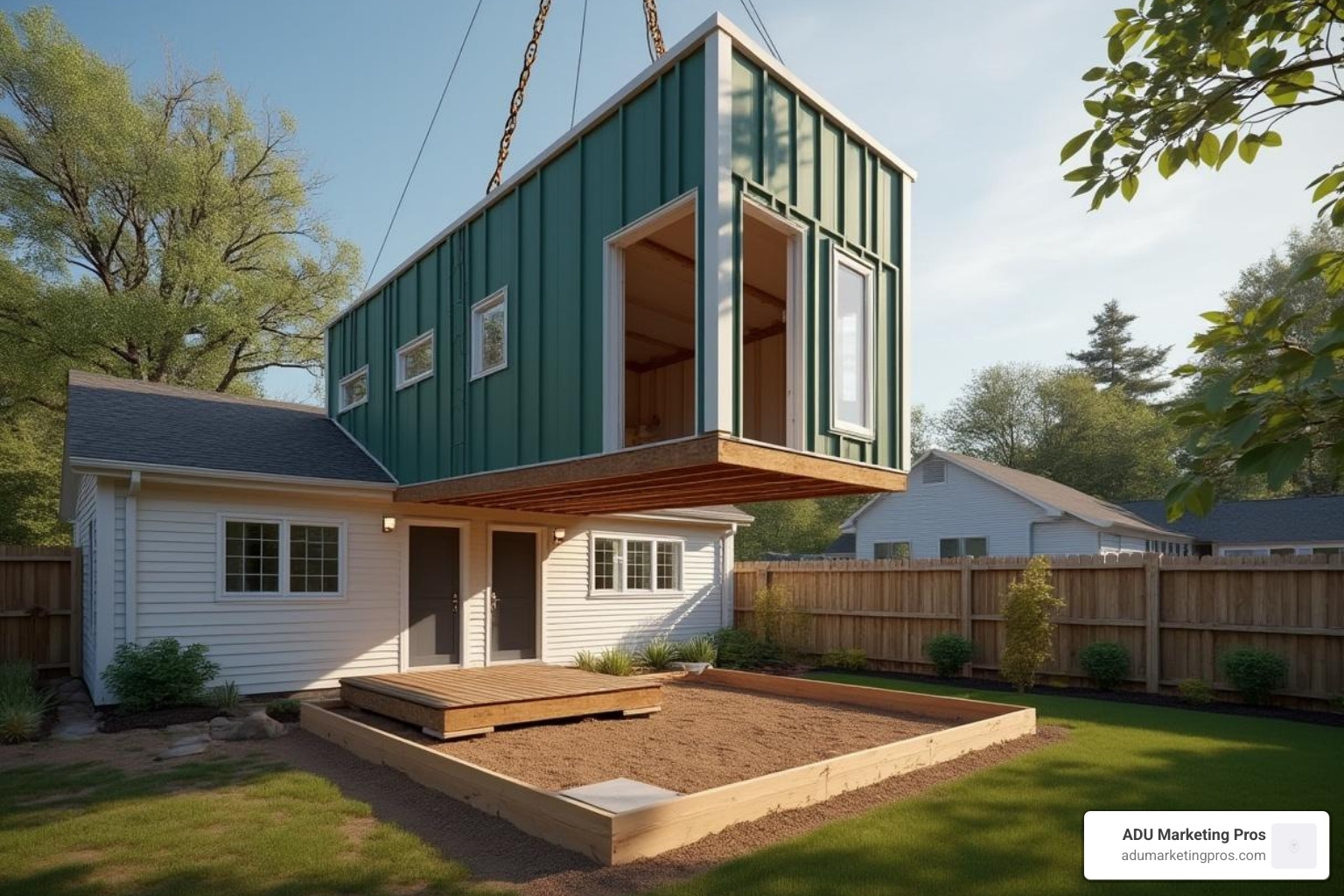
- Utility Hookups, Finishes, and Final Inspection: With the ADU in place, the final phase begins. This involves connecting the unit to the main utility lines—a process known as “buttoning up.” The builder then completes any remaining interior and exterior finishing work, such as sealing the seams between modules, drywall touch-ups, and connecting appliances. Finally, they coordinate all required inspections with the city. Upon passing the final inspection, you are granted a Certificate of Occupancy, officially making your new space legal, safe, and ready to enjoy.
Budgeting for Your SoCal Prefab ADU: Costs & Financing
For any homeowner considering a prefab adu southern california project, the most pressing question is inevitably, “What is the total cost?” While prefab construction is celebrated for its cost-predictability, understand the full, “all-in” or “turnkey” price, which extends beyond the price of the unit itself. For a preliminary overview, you can explore typical Prefab ADU California Costs.
Understanding the Total Project Cost
Your final budget is a composite of several distinct cost categories. A reputable builder will provide a transparent breakdown, but you should be familiar with these components:
-
The ADU Unit (The “Home”): This is the base price for the factory-built structure itself. It typically includes standard finishes, fixtures, windows, doors, and appliances. The cost varies significantly based on the size, number of bedrooms, and level of finishes you select.
-
Soft Costs (The “Paperwork”): This category includes all the necessary pre-construction expenses. It covers architectural and engineering fees, land surveys, soil reports, and the permit fees charged by your local city or county. While state law waives impact fees for ADUs under 750 sq. ft., other plan check and building permit fees still apply.
-
Site Work & Installation (The “Foundation & Logistics”): This is often the most variable part of the budget. It encompasses all the work done on your property, including demolition of old structures, grading and excavation, pouring the concrete foundation, the cost of transporting the unit to your site, the crane required to lift it into place, and all labor for installation and utility connections (water, sewer, gas, electric).
-
Ancillary Costs (The “Finishing Touches”): Be sure to budget for items that may not be included in a standard turnkey contract. This can include landscaping, building a deck or patio, new fencing for privacy, driveway or walkway paving, and any desired upgrades to appliances or fixtures.
While the ADU Cost Per Square Foot can be a helpful starting point, be aware that smaller units naturally have a higher cost per square foot because they still contain high-cost areas like a kitchen and bathroom. Always insist on a detailed, itemized quote to avoid surprises.
How to Pay for Your ADU Project
Financing an ADU is more accessible than ever, with several excellent ADU Financing Options available to homeowners:
- Home Equity Loan (HEL) or Line of Credit (HELOC): These are popular options that allow you to borrow against the existing equity in your property. A HEL provides a lump-sum payment, while a HELOC functions like a credit card, allowing you to draw funds as needed.
- Cash-Out Refinance: This involves replacing your current mortgage with a new, larger one. You receive the difference in cash, which you can then use to fund the entire ADU project.
- Construction Loan: Specifically designed for building projects, these are short-term loans that cover the costs of construction. They are often paid out in stages (draws) as work is completed and typically convert into a traditional mortgage once the project is finished.
- Government Grants and Programs: Be sure to investigate potential financial incentives. For example, the CalHFA ADU Grant Program provides qualified low-to-moderate-income homeowners with grants of up to $40,000 to cover pre-development and non-recurring closing costs.
Choosing the Right Prefab ADU Builder
Selecting the right partner for your prefab adu southern california project is the single most important decision you will make. The right builder acts as your trusted guide, ensuring a smooth, predictable, and successful outcome. The wrong one can lead to budget overruns, frustrating delays, and endless headaches. When evaluating potential contractors, it’s crucial to look beyond the initial price tag and focus on their experience, transparency, and comprehensive service.
Key Qualities of a Top-Tier Builder
Prioritize companies that demonstrate these essential characteristics:
- Deep Local Experience: A builder with a strong track record in Southern California, and ideally in your specific city or county, will have invaluable knowledge of local zoning codes, soil conditions, and logistical challenges like navigating narrow streets.
- True Turnkey Services: The best builders manage the entire project from start to finish. This means one company handles the feasibility study, design, engineering, permitting, fabrication, site work, installation, and final inspections. This single point of responsibility simplifies communication and accountability immensely.
- Unwavering Price Transparency: A reputable builder will provide a detailed, itemized quote that clearly outlines what is included and, just as importantly, what is not. They should be upfront about potential variables (like unforeseen rock during excavation) and how those contingencies are handled.
- A Verifiable Portfolio and Happy Clients: Ask to see a portfolio of recently completed projects that are similar to what you envision. Request a list of references from past clients and take the time to call them. Check online reviews on platforms like Yelp and Google to gauge overall customer satisfaction.
- Proactive and Clear Communication: Your builder should establish a clear communication plan from the outset. They should be responsive to your questions, provide regular progress updates, and be easy to reach. A dedicated project manager is a strong sign of a well-organized company.
- Proper Licensing and Insurance: Never work with a contractor who is not fully licensed, bonded, and insured in the state of California. You can verify a contractor’s license status on the California Contractors State License Board (CSLB) website.
Critical Questions to Ask a Potential Builder
Before signing a contract, have a detailed conversation and ask these questions:
- How many prefab ADUs have you completed in my specific city?
- Can you provide a detailed, all-in price quote and explain every line item?
- What is your realistic project timeline, from signing the contract to receiving the Certificate of Occupancy?
- Who will be my dedicated point of contact or project manager?
- How do you handle the permitting process with my local building department?
- What written warranties do you offer on the structure, materials, and workmanship?
- Can I visit a completed ADU or one currently under construction?
Frequently Asked Questions about Prefab ADUs in Southern California
As you consider a prefab adu southern california project, it’s natural to have a host of questions. Below are clear, detailed answers to some of the most common inquiries from homeowners.
How long does it really take to build a prefab ADU?
The total project timeline for a turnkey prefab ADU typically ranges from 6 to 12 months. This is significantly faster than a traditional site-built ADU, which can take 18 months or more. The timeline breaks down into a few key phases running in parallel: Design & Permitting (2-5 months for plan creation, engineering, and city review/approval), Factory Fabrication (this is very fast, often just 4-8 weeks), and On-Site Work (2-4 months for foundation, utility trenching, installation, and final hookups). The actual on-site installation of the unit itself is remarkably quick, often completed in just one or two days.
Can I customize my prefab ADU?
Absolutely. The term “prefab” does not mean one-size-fits-all. Most high-quality builders offer significant customization. You can typically choose from a portfolio of configurable floor plans and then act as the designer for your space. This includes selecting your own interior and exterior finishes from a curated menu of options, such as flooring, cabinetry styles, countertop materials, paint colors, and siding. Many builders also offer premium upgrades like vaulted ceilings, advanced appliance packages, or smart home technology. For a truly one-of-a-kind unit, you can work with an architect on Custom ADU Blueprints, which a prefab manufacturer can then build, though this will increase the cost and timeline.
What are the average costs for a prefab ADU in Southern California?
Understanding the full ADU Construction Cost is crucial. While costs vary based on size, location, and site conditions, a turnkey prefab ADU project is generally more budget-friendly and predictable than a traditional build. All-in project costs for a complete studio or one-bedroom unit often start in the low $200,000s, while larger two-bedroom units typically range from the high $200,000s to $400,000+. This total cost includes the unit itself, permits, site work, foundation, delivery, installation, and utility connections. The biggest variables are site-specific conditions (e.g., hillside properties or long utility runs) and the level of finishes you choose.
Will an ADU increase my property taxes?
Yes, building an ADU will trigger a reassessment of your property taxes, but it’s not as drastic as you might think. Your existing home will not be reassessed. Instead, your property tax bill will be a new “blended” amount. It will consist of the original assessed value of your primary home plus the new assessed value of the ADU construction only. This is a significant advantage over buying a new, separate property, which would be assessed entirely at its new, higher market value.
How much value does an ADU add to my property?
An ADU is a powerful financial investment that adds value in two primary ways. First, it generates a significant increase in your property’s resale value, often more than the cost to build it. Second, it can create a new stream of rental income. In many Southern California markets, even a studio or one-bedroom ADU can generate thousands of dollars per month in rent, providing a strong return on investment and helping to cover mortgage costs.
Conclusion: Is a Prefab ADU Your Next Smart Move?
The emergence of sophisticated prefab adu southern california options has fundamentally altered the landscape for homeowners seeking to add valuable living space. These innovative units deliver a powerful combination of benefits perfectly suited to the region’s needs: they are significantly more cost-effective and faster to build than traditional construction, they ensure superior quality through factory precision, and they minimize the disruption to your home and life. Whether your goal is to generate substantial rental income, keep family close in a multi-generational living arrangement, or build a dedicated, professional home office, a prefab ADU stands out as an exceptionally versatile and intelligent solution.
With California’s state laws now firmly in support of ADU development, the regulatory problems have been lowered, creating a golden opportunity for property owners. This legislative tailwind, combined with the clear advantages of prefabrication, makes a compelling case for moving forward.
However, the success of your project ultimately depends on a single, critical factor: partnering with the right team of professionals. An experienced, transparent, and reputable builder is not just a vendor; they are your guide through the entire process, expertly managing design, city regulations, and the complexities of installation. At ADU Marketing Pros, we recognize that connecting homeowners with these top-tier experts is the key to a successful project. We specialize in ADU architect marketing, ensuring that the best, most qualified builders and designers are visible, so you can confidently find the ideal partner for your vision.
If you are a Southern California homeowner with a backyard and a vision for more, a prefab ADU is more than just a smart move—it’s an investment in your property, your financial future, and your quality of life.



